We may receive a commission when you use our affiliate links. However, this does not impact our recommendations.
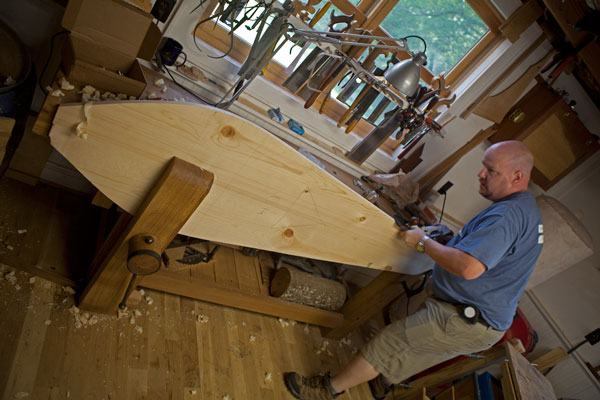
We may receive commission when you use our affiliate links. However, this does not impact our recommendations.
When I die, I want to leave this world in the same way I lived in it. As a woodworker who has spent his entire life building furniture for myself and others, I couldn’t imagine being placed into a box that someone else made.
In 2005, I read this article in TheNew York Times about Chinese coffins that were made much like a dugout canoe (and were banned by the government). That set me off on a long search for a coffin that reflected my views as a woodworker. About a year ago, I found it.
I hope to be cremated, but I really won’t have much say in the matter when the time comes. So the forms of coffins I like are unordained, simple and inexpensive. But I have no interest in building a shipping crate.
When I finally read “Coffin-Making and Undertaking,” edited by Paul Hasluck (printed in 1913 and republished in 2009), I found two coffins that I wanted to build. One was a simple coffin popular in the southern counties of England that had kerf-bent sides and some interesting geometry. The other coffin was the Lancashire form, which had sides that were bent around the bottom.
The Lancashire coffin also had the bonus of having an interesting and somewhat challenging technique: To bend the sides around the bottom you light a fire in the unassembled coffin; the heat from the fire allows you to bend the sides in place.
After talking to some of my woodworking friends, I found I wasn’t alone in my desire to build a coffin, so six of us got together this weekend for a couple days of building coffins and experimenting with the different techniques.
We used off-the-rack 1×12 white pine from the hardware store, plus 6d sinker nails to assemble everything. Nothing fancy.
The first challenge was figuring out how large to make the coffins. “Coffin-Making and Undertaking” lists 12 standard sizes, but those sizes cover people only up to 5’ 6” tall. So we had to extrapolate to determine the proper proportions for people 6’ and taller.
After determining the overall sizes, we had to lay out the shape of the bottom. For the coffin from the southern counties, layout was easy. You plotted six points on the bottom board and connected the dots. You cut out the shape of the bottom and added a couple of curves that were laid out using the sidewall of a coffin smoothing plane.
The Lancashire coffin has a shape like an upside-down teardrop, so the layout was more complex. It involves a series of nails driven into the bottom. Then we bent a long, skinny batten through the nails and traced its shape on the bottom board.
The sides of both coffins taper in width – they are wider up at the head and narrower at the foot. For the southern coffin, we cut five kerfs on the inside of each side, then we poured boiling water over the kerfs and bent it around the bottom board, nailing as we went.
For the Lancashire coffin, things were more involved. The sides are nailed to a board at the head of the coffin. Then you fill the head of the coffin with shavings, light them on fire and bend the sides around the bottom with the assistance of a “breast board” and a homemade clamp.
The first time we tried it, the coffin sides split out at the bottom edge. We managed to get the coffin together and repair the splits, but we thought we could do better if we built a second one.
So after the healing power of Dewey’s pizza, we built a second Lancashire coffin and altered a few of the variables in our favor.
1. We increased the width of the head board at the top of the coffin to 12”, up from 8”.
2. We also soaked the sides for more than two hours. Kiln-dried wood is difficult to bend (some would say almost impossible). So we thought that soaking our kiln-dried pine might help.
3. We added some more heat. In addition to the fire in the coffin, we used two gas torches to apply heat to the outside of the side pieces.
These changes seemed to make a difference. The sides bent easily around the bottom with less fussing and only one small split, which was easily repaired.
So now my house is filled with three half-finished coffins – I still need to make two lids and clean everything up so they look nice. And, to be honest, I’m going to build a coffin for myself entirely by myself using some sugar pine I have squirreled away for this project.
So what will become of the three coffins from our weekend? Well my music-loving daughter has asked for one of them in which to store her vinyl records (I’ll need to add some temporary shelves). And my wife noted that Halloween is just around the corner.
— Christopher Schwarz
Here are some supplies and tools we find essential in our everyday work around the shop. We may receive a commission from sales referred by our links; however, we have carefully selected these products for their usefulness and quality.



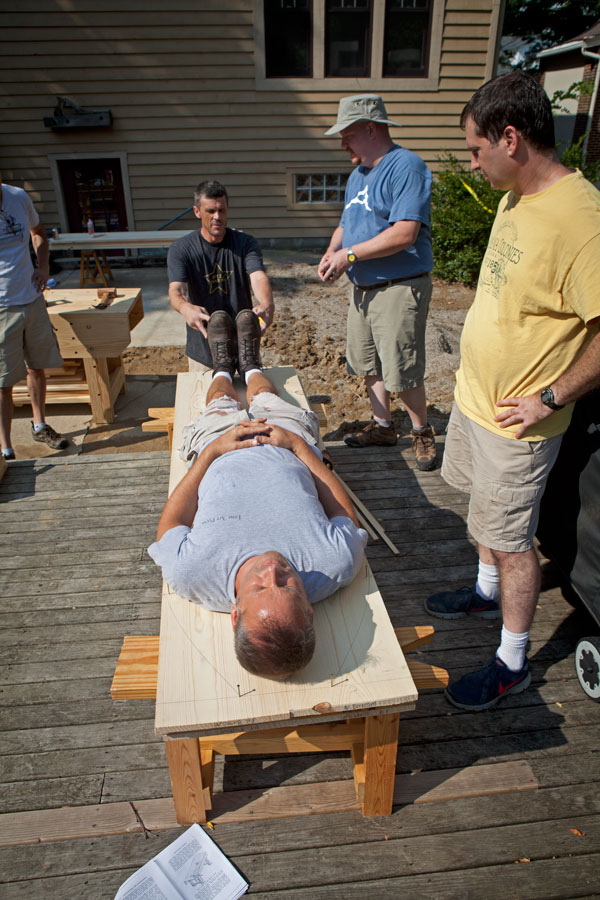
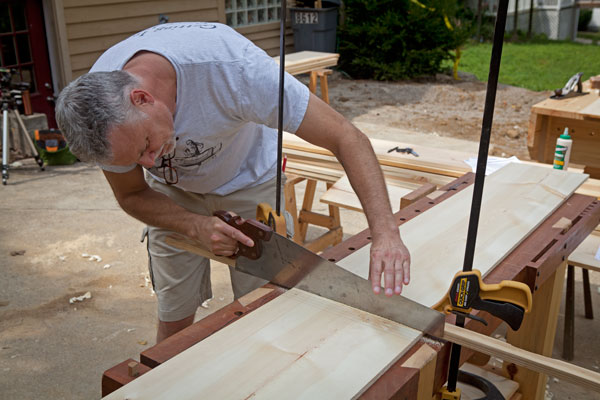
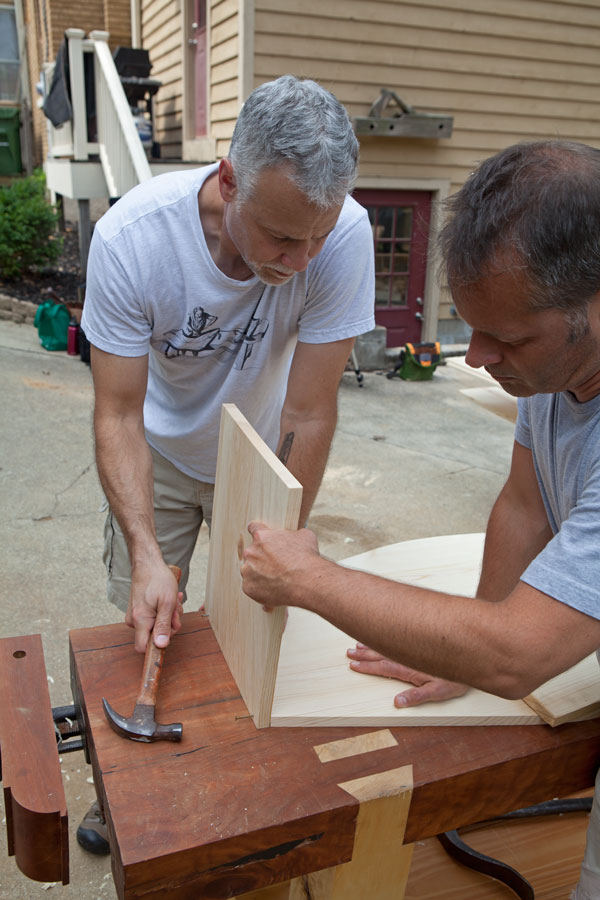
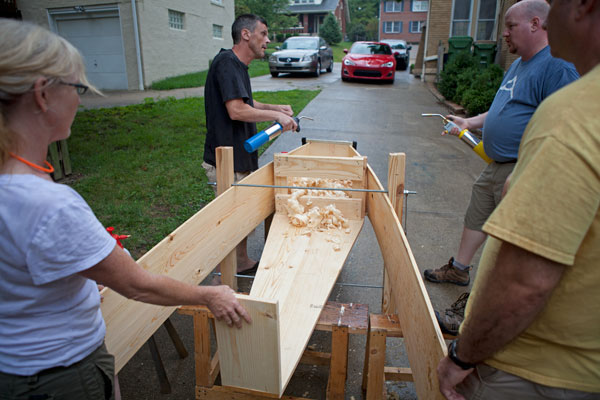
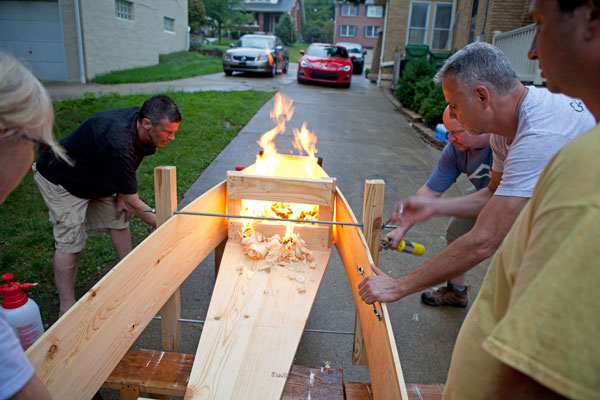
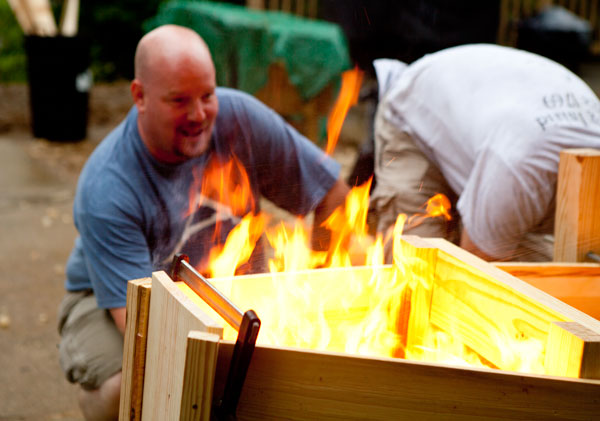
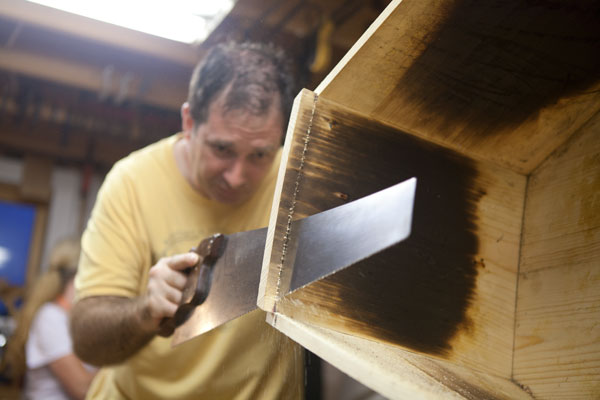






msiesmsen’s note on Minnesota laws on caskets was very informative. Can someone provide Ohio and Pa laws regarding “home made” caskets/coffins. I have stopped short of building my own (and “gifts” for my family members) because of potential legal issues that I don’t have the time to investigate myself. Maybe I’ll make one any how, I can always cut it in half and make 2 tool chests! If Chris plans on holding a class, I’d like to reserve a spot. jrp
Wood coffins are a great idea and I plan to build one for myself sometime when I’m sufficiently old… only 70 now, understand.
One thing to think about that’s consistent with this idea… consider a “green burial”, which means you get put into the ground in a wooden casket (or other suitable biodegradable material), w/o embalming. You then decompose or, as I like to imagine, are compost for a nice tree. Going the typical route (embalming, metal casket, concrete vault, and so on) is very energy and resource intensive. For example, every year, 30 million board feet of fine hardwoods are used in coffins in the USA. What a waste of good furniture wood! Cremation is also very energy intensive. According to the The Natural Burial Cooperative, the amount of non-renewable fossil fuel needed to cremate bodies in North America is equivalent to a car making 84 trips to the Moon and back… each year! Dust to dust as the good book says.
So, homemade wooden coffins (preferably a nice, inexpensive softwood) — YES! And green burial — YES too. Time to head out to the shop. Never know when that coffin will be needed ;-D
We bought a wooden casket from New Melleray Abbey for my mom (I checked with her beforehand and she liked the idea). The caskets they build are not quite as plain as the ones from St. Joseph Abbey. In fact, it was like a fine piece of furniture, almost too nice just to bury someone in.
They had the casket at the funeral home in Florida the day after I ordered it.
2013-07-21 12.21.31-1.jpg
This is a cremation box I made for a friend’s guide dog.
I looked in to this as well when I made a coffin at HandWorks. Mine was kerf bent from home center pine as well.
While I don’t really care what happens to my corpse a home built coffin made by someone close to me would be nice. Here in Minnesota you can make and use your own coffin. Here are the rules.
Caskets
Minnesota law allows consumers to purchase a casket from a funeral home or
from other providers such as a casket store, buying club or on the internet. You
may also make your own casket if you wish. A funeral home cannot charge a
handling fee when you do not purchase the casket from them.
Some cemeteries require the use of an “outer burial container.” An outer burial
container is an enclosure that surrounds the casket in the ground and prevents
the grave from caving and it thus helps keep cemetery maintenance costs down.
An outer burial container is usually made of cement, metal or plastic and may be
purchased from some cemeteries or from a funeral home.
A “burial vault” is a sealed outer burial container with a metal or plastic lining. A
“grave box” is a non-sealing outer burial container. Outer burial containers are
not required by state law but rather may be required by policy of some
cemeteries.
If cremation is to take place in Minnesota, the body must be delivered to a
licensed crematory along with the documents listed above. (A body to be
cremated outside Minnesota would require that the cremation laws of both states
be followed.) The body must be delivered in a leak-proof cremation container.
Caskets are not required for cremation in Minnesota. Crematories typically do
not allow the use of metal containers for the cremation process.
Time-lines
A body must be buried or entombed in a legally recognized cemetery, or
cremated within a reasonable amount of time following the death. If embalming
is not desired, Minnesota law requires that the body be buried or cremated within
72 hours of the time the body is released from the place of death or released by
the coroner or medical examiner. If embalming is not chosen, refrigeration of the
body allows the time-line to be extended up to six days. Individuals without
access to refrigeration may extend the time-line to four days by using dry ice.
Public Visitations
The viewing of the deceased by the public requires that the body be either
embalmed by a licensed mortician or that the body be refrigerated using dry ice.
When using dry ice, the visitation may take place for up to four days following the
death, but must take place on private property such as in a home. (Take
necessary precautions when handling dry ice.)
Private Visitations
Private viewing of a dead human body may take place in a private place without
embalming or without the use of dry ice. This private reviewal must take place
within the three-day time limit mentioned above. A private visitation may only
include those on the list of persons found in MN Statutes 149A.80.
I figured to make the cofin leak proof by caulking it with wax (I was thinking toilet bowl gasket) or lining it with plastic sheating with a fabric cover. These would be excellent coffins for cremations IMHO.
It is best to know the rules in your area to save those dealing with your leaky, rotting carcass any added misery while following your wishes.
I am thinking that we need to start a sort of Soap Box Derby using wooden coffins for cars, any takers?
http://saintjosephabbey.com/woodworks.php
The brothers of St. Joseph Abbey, St Benedict, Louisiana construct simple caskets as part of their vow of “Ora et Labora”, to pray and work.
I would never want to have a completed coffin in my home. That would mean I would be using it. I would rather have a half completed one.
My husband made urns for my parents out of curly cherry. He also made an urn for my brother in law who was a lifetime mechanic. That urn, he made to look like a mechanics 4 drawer tool chest. The greatest compliment was at the visitation/viewing when several of the men my brother in law worked with couldn’t believe how real it looked I’ve told him i would like for him to make our urns while he still is quite skilled at wood work.
I want to built a more “traditional” casket and have the “box” portion pretty well figures out until I come to the lining. I could use some guidance on how to handle the interior lining aspect of the project
This project is the ultimate end all mortise…. and that makes us the tenon.
Various siblings & myself have built coffins for my father, mother and a sister. And sadly, will probably soon have to build another for a newly born grandson. Our society is generally too far removed from the process of dying & this is a wonderful way to deal with death. I could go on about that, but we’re talking more about building here.
I do have one piece of advise; when figuring out the length, be sure to add a few extra inches. The feet, post-mortem, tend to point downwards. This can create difficulties if the coffin was a bit snug to start with. Don’t ask how I know (sorry Dad).
It is really nice that your passion was not coffee or you will be ground up and stored in the freezer!
Dave
Not sure why there was a need to scale up the coffins for people over 5′ 6″… It looks like there was plenty of height available to bend the knees and effectively shorten the corpse. That approach would be reminiscent of riding in the compact cars of our youth without any concerns about it being uncomfortable. ;~)
In some neighborhoods people rarely talk to each other…
derek probably wants to know if you are planning a coffin book. 🙂
This looked like an excellent exercise in which some beers may have been consumed
I hope those flames are not foreshadowing your eternal resting place!
What’s really creepy is the dead guy helping to make coffins…
Did you tell John he’d end up the first occupant of the new coffin if sawed too deep? (See pic. #2)
This is interesting. I would have assumed all coffins of this style would just have 6 individual boards to make up the sides.
Your neighbors must have been either amused or mortified!?!